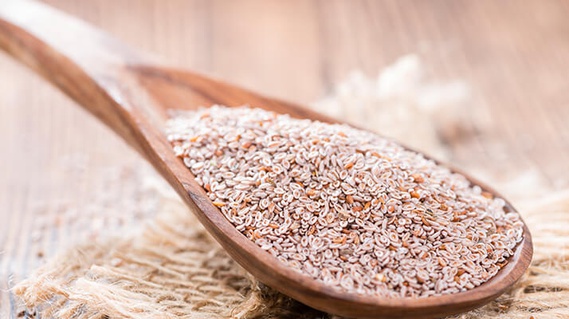Do you know a plant called psyllium? Its botanical name is Plantago Arenaria or Plantago Psyllium of the plantaginaceae family. Commonly known as Flea Weed, Psyllium or Pulicaria, its seeds bear an uncanny resemblance to fleas, these small microscopic insects, and it is this resemblance that inspired its vulgar name. Moreover, in Greek, Psyllia means flea.
Registered in the French pharmacopoeia since 1965, the seeds and their husks that we use are very useful in phytotherapy and each of us should have some in his cupboard of natural medicines. It was not until the late 1990's that psyllium was credited with useful therapeutic properties to support health. Finally, manufacturers will be able to indicate on their packaging whether they use psyllium as a thickener or stabilizer.

Mainly used for the comfort of the digestive system, psyllium is used for its various properties: for hypercholesterolemia by reducing blood cholesterol, diabetes by reducing blood sugar, irritable bowel syndrome, diverticula but more commonly to alleviate constipation and even diarrhea.
Beware, note that serious diseases such as diabetes for example must be followed by a competent doctor and self-medication is not at all advised. Talk to your doctor first.
How does this plant work?
Psyllium is a mucilage plant, which means that it absorbs water from food to form a viscous gel that facilitates transit. This sticky liquid simply increases the weight of the stool and allows for better evacuation. Contrary to the other laxatives, psyllium does not involve any side effect and it can be taken to stabilize the digestive function or really to mitigate a problem of chronic constipation.
Attention nevertheless that the catch of psyllium requires to drink much water to avoid forming clots but also to allow him an optimal installation throughout the digestive circuit.
Psyllium is a really complete product because it also fights against liquid stools: diarrhea, dysentery, fecal incontinence and it also treats colon irritation like irritable bowel syndrome, functional colopathy. This could seem contradictory but it is precisely its capacity to absorb liquids that will allow psyllium to regulate a concern of liquid stools, simply by absorbing the excess of water.
By increasing the food bolus by its swelling in contact with liquid, psyllium could also be used to increase the feeling of satiety if the objective is to restrict the food portions
Blond or black psyllium?
Whether you go to a pharmacy, an organic store or an herbalist, you will have a choice. Ideally, to treat a transit problem, it is better to opt for the blond version which is much less aggressive and irritating for the digestive sphere.
How to consume psyllium?
- First of all, mix 1 teaspoon with a large glass of water of more or less 100 milliliters. The doses can be adapted according to your needs and therefore, as the days go by, you can increase the dosage while evaluating your personal needs.
- Increase the dosage after a few days from once to twice and then slowly to three times a day.
- After several days, it is possible to increase the dose to 1 tablespoon, 3 times per day.
You are only judge to estimate the evolution of your digestive evil to be and the state of your transit. Therefore, analyze your situation over time. - It is best to take psyllium one hour before or after taking your medication. The studies are not yet clear, but in order to avoid drug absorption, let's take it away.
Psyllium is a very interesting remedy when one is confronted with transit problems. It is interesting to have some at home to deal with small digestive problems that may appear suddenly.




